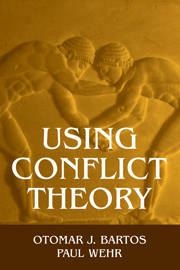Book contents
- Frontmatter
- Contents
- List of Figures and Tables
- Acknowledgments
- 1 Introduction
- 2 Understanding Conflict
- 3 Development of Incompatible Goals
- 4 Application to the Civil Rights Struggle
- 5 Emergence of Overt Conflicts
- 6 Application to a University Conflict
- 7 Escalation and Deescalation
- 8 Application to Conflict in Bosnia
- 9 Making Conflict Work Economically
- 10 Understanding and Managing Conflicts
- Appendix: Prelude to the Dissolution of Yugoslavia
- Notes
- References
- Index
10 - Understanding and Managing Conflicts
Published online by Cambridge University Press: 05 June 2012
- Frontmatter
- Contents
- List of Figures and Tables
- Acknowledgments
- 1 Introduction
- 2 Understanding Conflict
- 3 Development of Incompatible Goals
- 4 Application to the Civil Rights Struggle
- 5 Emergence of Overt Conflicts
- 6 Application to a University Conflict
- 7 Escalation and Deescalation
- 8 Application to Conflict in Bosnia
- 9 Making Conflict Work Economically
- 10 Understanding and Managing Conflicts
- Appendix: Prelude to the Dissolution of Yugoslavia
- Notes
- References
- Index
Summary
in this final chapter, we review the most important principles and methods of understanding and managing conflicts, then suggest how conflict students might use them in building their personal and professional lives. Whether these insights are valuable to you is, of course, for you to decide. But you will probably agree that you did learn something new. But what exactly was it? Let's go over the main points.
Understanding Conflicts
You may feel that exact definitions are, by and large, a waste of time. We agree, but only up to a point: there are a few basic concepts that you really ought to know. The concept of conflict is one of them.
Conflict
You may recall that, in Chapter 2, we defined conflict as a situation in which actors use conflict behavior against each other to attain incompatible goals and/or express their hostility. Chances are that this definition, when you first encountered it, did not mean much. But it should mean more now that you have explored, in depth, the meaning of the three main concepts in that definition: conflict behavior, incompatible goals, and hostility.
Perhaps you remember that “conflict behavior” can be viewed both as a set of categories and as a continuum. We distinguished two main categories of conflict behavior, noncoercive (which includes pure cooperation, promising reward, and persuasion) and coercive (which includes threat of coercion, nonviolent coercion, and violent coercion).
- Type
- Chapter
- Information
- Using Conflict Theory , pp. 174 - 187Publisher: Cambridge University PressPrint publication year: 2002



